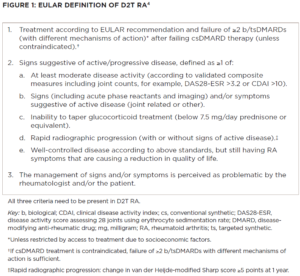
Despite an expanding armamentarium of disease-modifying treatments for rheumatoid arthritis (RA), some patients with RA remain symptomatic.1 Current treatment guidelines from both the ACR and the European Alliance of Associations for Rheumatology (EULAR) recommend treat-to-target strategies to achieve remission or low disease activity, and patients want to feel better.2,3 So how can we best help patients with difficult-to-treat (D2T) RA?
In 2020, EULAR took the first steps toward evidence-based guidance for this population, publishing two articles that address the definition and management of difficult-to-treat RA. Here, lead author György Nagy, MD, PhD, DSc, head of the Department of Rheumatology and Clinical Immunology, and professor, Department of Genetics, Cell and Immunobiology, Semmelweis University, Budapest, Hungary, offers insights on what this work means for practicing rheumatology providers and our patients.
Difficult-to-Treat RA Defined
The first step in solving any problem is properly identifying it. By way of results from an international survey of rheumatologists and expert opinion, a multidisciplinary task force created the EULAR definition of D2T RA.4 The task force defined the condition by three mandatory criteria (see Figure 1, below).
Simply stated, D2T RA can be summarized as a patient who has 1) failed two or more biologic or targeted synthetic disease-modifying anti-rheumatic drugs (bDMARDS or tsDMARDs) with different mechanisms of action (MOA) after failing conventional synthetic DMARDs; 2) has active disease; and 3) has poorly controlled disease as perceived by the rheumatologist and/or patient.
If you’re reading these criteria and thinking to yourself, “I could name 20 patients who meet these criteria without even trying,” welcome to the club. An international survey of rheumatologists confirmed the unmet needs of this group.5 These patients are more common than we’d like them to be, especially given the myriad therapeutic options now at our disposal.
Uniform terminology and a clear definition of D2T RA are the first steps toward designing clinical trials to better care for this population. Professor Nagy said, “The definition is necessary to select the appropriate patient population, and our EULAR definition was the first precise characterization of this important patient cohort.”
This definition still needs to be validated, but the Nagy et al. hope the “definition presented here will provide a robust and consistent identification” of these patients, as well as a “platform to define a group of similar patients for research.”



